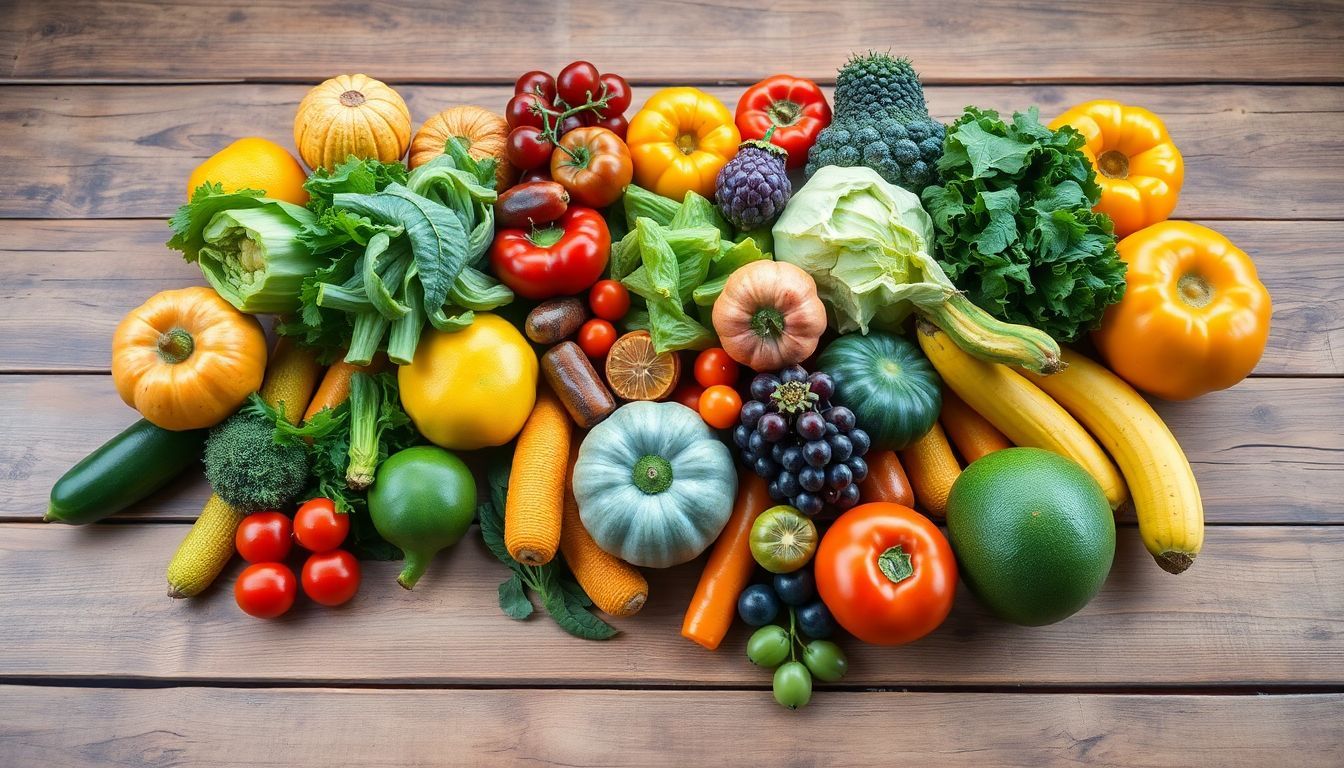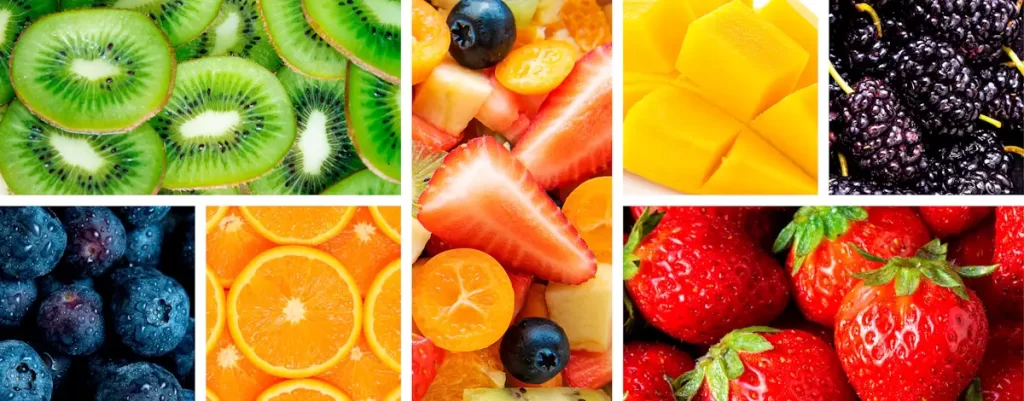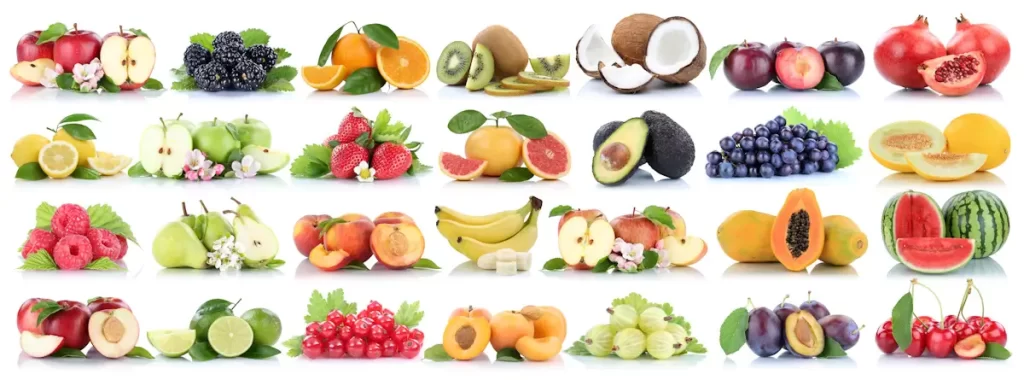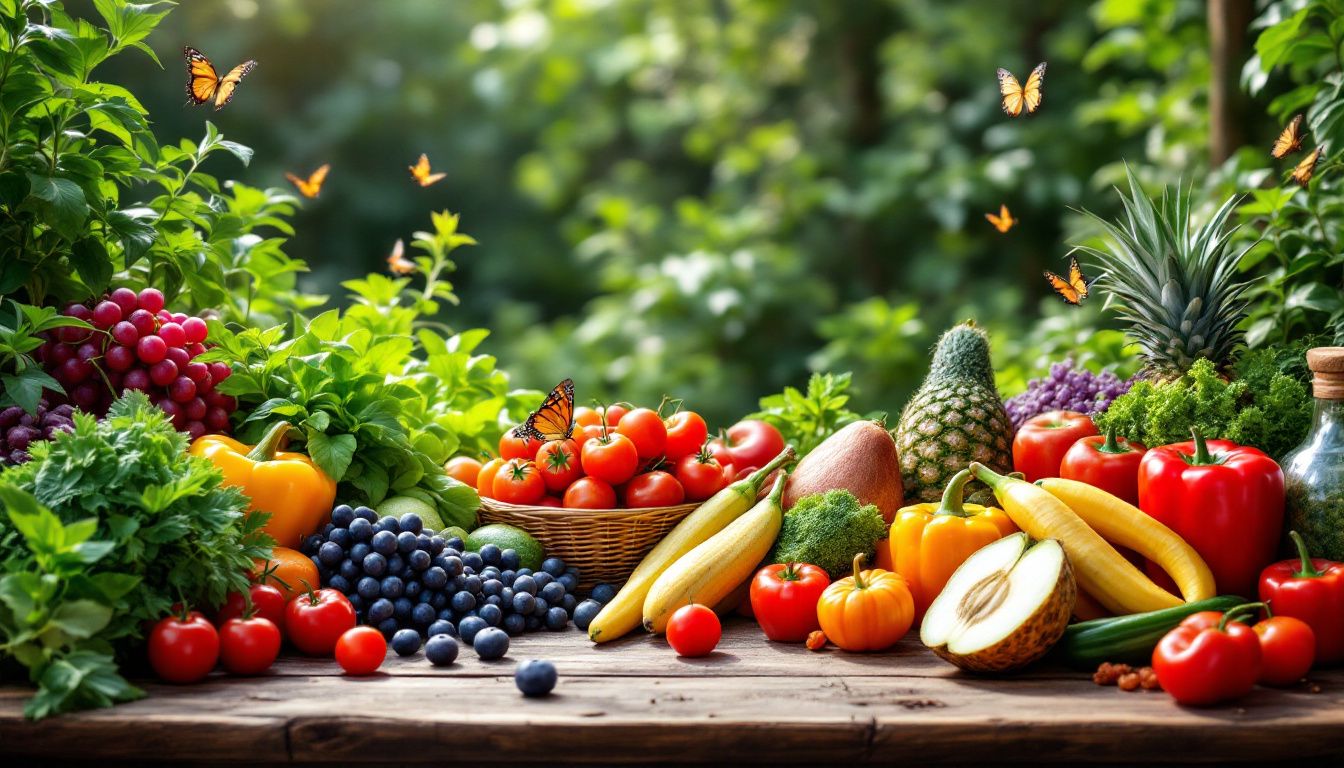Struggling to eat enough fruits and vegetables? Studies show five servings a day can lower your risk of heart disease, cancer, and other illnesses. This guide will break down simple tips, serving sizes, and how to make healthier choices every day.
Thank you for reading this post, don't forget to subscribe!Keep reading—it’s easier than you think!
Key Takeaways
- Aim for 5 servings a day: 2 cups of fruit and 2.5 cups of vegetables for a balanced diet. Fresh, frozen, or canned options all count.
- Eating up to 4 cups (500g) daily can lower risks of heart disease, diabetes, and cancer. The best benefits come with up to 800 grams per day.
- Whole fruits are better than juice due to more fiber and fewer added sugars; dried fruit portions (½ cup) should be kept smaller because of concentrated sugars.
- Barriers like cost or limited access make it harder for low-income areas to meet recommended intake levels; seasonal shopping can save money and provide fresher produce.
- Small strategies—like adding veggies to meals, snacking on fresh produce, or prepping ahead—can help meet goals without stress while improving overall health over time.
Current Recommendations for Fruit and Vegetable Intake
Eating enough fruits and vegetables supports a healthier body. Experts suggest daily servings to help maintain strong health and reduce disease risks.
Fruits: 2 cups per day
Two cups of fruits a day fit into a 2,000-calorie diet. A medium-sized fruit, like an apple or orange, counts as one cup. Large bananas also equal one cup. For grapes, about 22 pieces make up the same amount.
Dried fruit is denser; just half a cup equals one full serving.
Whole fruits are better than juice for daily intake. At least half of your fruit servings should come from fresh forms instead of juice with added sugars. This ensures higher fiber and fewer empty calories while offering key nutrients like vitamin C and potassium.
Vegetables: 2 1/2 cups per day
Vegetables are a crucial part of any healthy diet. Experts recommend eating 2 1/2 cups daily, based on a 2,000-calorie diet. This includes fresh, frozen, or canned vegetables—each counts as one cup per serving.
Raw leafy greens like spinach or lettuce are different; two cups of these equal just one vegetable serving.
Drinking 100% vegetable juice is also an option. One cup of this counts the same as a serving of whole vegetables. To meet your goal, try adding red peppers to sandwiches or carrots as snacks.
Small changes like this make reaching your daily intake easier while boosting vitamins and minerals in meals.

The Science Behind Fruit and Vegetable Recommendations
Eating enough fruits and vegetables supports better health. They can help lower the chances of serious diseases, like heart problems and diabetes.
Benefits of adequate intake
Eating 2-3 cups of vegetables and 1-2 cups of fresh fruit daily supports overall health. Studies show that consuming up to 500 grams (about 4 cups) lowers the risk of chronic diseases like type 2 diabetes, heart disease, and certain cancers.
A plant-based diet can also help with weight management by offering low-calorie nutrients while keeping you full longer.
Higher intake is linked to better cardiovascular health and reduced obesity rates. Beta carotene from colorful fruits and vegetables boosts your immune system. Evidence suggests eating around 800 grams per day maximizes benefits without overdoing it.
This keeps blood sugar levels steady, limiting negative impacts tied to poor nutrition or fast food habits.
Risks of insufficient intake
Low fruit and vegetable consumption raises the risk of chronic diseases. Conditions like cardiovascular disease, diabetes, and obesity are closely linked to poor dietary choices. Failing to meet the recommended 1.5–2 cups of fruit and 2–2.5 cups of vegetables daily can harm overall health.
Insufficient intake contributes to weight gain and higher mortality rates in the U.S. Healthy eating patterns rely on proper servings for vital nutrients that prevent long-term issues.
As per studies, populations with lower incomes often face challenges accessing fresh produce, which adds to these risks.
Chronic diseases thrive where fruits and vegetables lack.
Strategies to Increase Fruit and Vegetable Consumption
Making fruits and vegetables a regular part of meals can feel simple with a little planning. Small changes, like switching snacks to fresh options or adding more color to your plate, can make big health impacts over time.
Integrating more into meals
Adding fruits and vegetables to meals can be simple and tasty. Small changes can make your diet healthier quickly.
- Add chopped vegetables to pasta sauces, soups, or stews. Bell peppers, carrots, and spinach work well. This boosts vegetable intake without changing the main dish.
- Include fresh fruit as a topping for breakfast foods like cereal, oatmeal, or yogurt. Blueberries, bananas, and strawberries add flavor and nutrients.
- Use leafy greens such as kale or spinach in sandwiches or wraps instead of only using lettuce. This adds more vitamins and minerals.
- Swap out half the meat in dishes like tacos or stir-fries for beans, mushrooms, zucchini, or diced eggplant for extra fiber and color.
- Grill or roast vegetables like zucchini, asparagus, or sweet potatoes alongside chicken or fish for a balanced plate with less fat and more vitamins.
- Replace rice with cauliflower rice or spaghetti noodles with spiralized zucchini for plant-based options that are lower in calories but high in nutrition.
- Blend frozen fruit into smoothies for a quick meal boost while cutting down on added sugars from other drinks like juice or soda.
- Prepare mashed potatoes with steamed cauliflower mixed in—this keeps the texture creamy but lowers calories while adding nutrients.
- Top pizzas with colorful vegetables like bell peppers, onions, mushrooms, and tomatoes instead of just meats to improve the nutritional profile without making large sacrifices in flavor.
- Keep pre-washed salad greens handy to toss into any meal as an easy side dish that requires little effort but meets part of the daily vegetable recommendation!

Using fruits and vegetables as snacks
Snacking on fruits and vegetables is a simple way to improve your diet. These snacks are nutritious, easy to prepare, and perfect for any time of the day.
- Eat fresh fruit like apples or bananas as a quick snack. They are portable and require no prep work.
- Make fruit smoothies with fresh or frozen fruit for a refreshing treat. Use no added sugars for healthier options.
- Keep cut veggies like carrots, celery, or bell peppers in the fridge for easy grab-and-go snacks. Pair them with hummus for extra flavor.
- Replace chips with baked veggie crisps or kale chips from the store or homemade versions at home. They are lower in salt and healthier than traditional snacks.
- Snack on whole-grain crackers topped with avocado slices or tomatoes for added fiber and flavors. This can also support healthier eating patterns overall.
- Use small containers to pack fruits like grapes, berries, or pineapple chunks as quick finger foods you can eat at work or school.
- Try dried fruits like raisins but watch portion sizes due to concentrated sugars; they make great emergency desk snacks!
- Blend veggie-based soup cups using store-prepped blends alongside healthy spices without excess sodium—for a warm afternoon option.
9 Consume seasonal fruits often since they tend fresher while aiming within supermarkets yet reasonably cheaper generally-market-wise-rich!
Simple strategies for a healthier diet by cutting back on sugar and salt
Cutting back on sugar and salt can improve health. It helps lower the risk of heart disease, obesity, and chronic conditions.
- Replace sugary drinks with water or unsweetened tea. Soft drinks and fruit juices often contain high amounts of added sugar.
- Choose fresh fruit instead of desserts like cake or cookies. Natural sugars in fresh fruits are healthier options.
- Use herbs, spices, garlic, or lemon juice to flavor food instead of salt. This reduces sodium intake while adding bold flavors.
- Read nutrition labels carefully before buying food. Look for “low-sodium” or “no added sugar” products.
- Avoid processed foods like canned soups and fast food meals. These are often high in hidden salts and sugars.
- Cook meals at home more often to control ingredients. Homemade dishes let you lower sugar and salt without losing taste.
- Snack on raw vegetables like carrots or celery instead of chips or pretzels. They’re naturally low in both salt and sugar.
- Gradually reduce sugar in coffee, tea, or recipes over time. Smaller changes can help you adjust your taste buds slowly.
- Shop at grocery stores that offer healthier options such as frozen fruits without syrups or canned vegetables without added salt.
- Add potassium-rich plant-based foods—like bananas—to your diet to balance excess sodium in the body effectively!
Common Misconceptions About Fruit and Vegetable Intake
Many people think all fruit forms, like fresh, canned, or dried, offer the same benefits. Others assume eating a lot more than recommended servings is always better for health.
Myth: All forms of fruits are equally beneficial
Fresh fruit contains fiber, which helps with digestion. Juices lack this fiber and often have added sugar. For example, a glass of orange juice can pack as much sugar as soda without the same health benefits.
Frozen fruit is almost as nutritious as fresh options because freezing locks in nutrients. Canned fruits may lose some vitamins during processing and might include syrup or extra salt.
Whole fruits are typically a healthier choice compared to processed ones.
Myth: More is always better
All forms of fruits aren’t equal, and overeating isn’t always better either. Consuming more than the recommended 2 cups of fruits and 2 1/2 cups of vegetables daily doesn’t guarantee extra health benefits.
Health experts say “quality” matters over “quantity.” Whole fruits are healthier than juices because they keep fiber intact. Overeating any food—including healthy ones—can lead to weight gain or upset the nutrient balance.
People with certain conditions may even need less produce. For example, some kidney patients avoid high-potassium foods like bananas or spinach. Consulting a dietitian can help tailor intake for your body’s needs.
Eating smarter—not just more—is key to improving health without unnecessary risks.
The Role of Fruits and Vegetables in Disease Prevention
Eating fruits and vegetables may lower the risk of heart problems and some long-term illnesses. They help your body fight inflammation and support overall health.
Impact on cardiovascular health
Eating more fruits and vegetables helps your heart. Studies show that every added 200 grams per day can lower coronary heart disease risk by 8%. Stroke risk drops even more—up to 16% with higher intake.
Aim for up to 800 grams daily for the best protection.
Fresh fruit and leafy greens are beneficial in reducing cardiovascular diseases. Their vitamins, antioxidants, and fiber work together to support healthy blood flow. This simple habit lowers the chances of serious problems like heart attacks or strokes over time.
Influence on obesity and metabolic syndrome
Eating plenty of fruits and vegetables can lower the risk of obesity and metabolic syndrome (MetS). MetS includes conditions like high blood pressure, excess body fat, and unhealthy cholesterol levels.
In the U.S., MetS rates rose from 32.9% in 2003-2004 to 34.7% in 2011-2012. Studies show that higher fruit and vegetable intake is linked to a reduced risk of these health issues.
A meta-analysis of 16 studies confirmed this connection. It found that people who ate more fruits and vegetables were less likely to develop metabolic syndrome. These foods are full of fiber, vitamins, and antioxidants—key nutrients that help regulate weight, blood sugar, and cholesterol levels.
Simple choices like fresh or frozen fruit as snacks can make a big difference in staying healthy over time.

How to Properly Measure Fruit and Vegetable Servings
It can be tricky to know what counts as a serving. Using simple visual cues makes it easier to measure portions correctly.
Visual guides for measuring servings
Serving sizes can be tricky. Using simple visual guides makes it easier to measure fruits and vegetables.
- When measured loosely packed in a bowl, one cup of raw leafy greens equals two cups. Think spinach or lettuce.
- A medium-sized fruit like an apple or orange is about the size of a baseball—this counts as one cup.
- Half a cup of dried fruit, like raisins, fills about half of a small fist or a snack-sized baggie.
- One serving of chopped vegetables, such as carrots or peppers, fits roughly into your cupped hand (one cup).
- A whole grain serving, like one slice of bread, matches the size of a standard playing card stack.
- Dairy servings are easy—one cup of milk or yogurt fills the same space as an average mug or drinking glass.
- Protein servings equal 5-ounce equivalents; this could be one chicken breast or a chunk the size of your palm if plant-based tofu is used.
- Frozen fruits and veggies measure the same as fresh—one full measuring cup equals one serving.
Simple habits with these guides make healthy eating stress-free!
Examples of one serving size
A serving size helps track your daily fruit and vegetable intake. It ensures you meet dietary guidelines for a balanced diet.
- One cup of raw or cooked vegetables equals one serving. Think carrots, broccoli, or peppers.
- Two cups of leafy greens like spinach, lettuce, or kale count as one serving.
- A single medium apple, banana, or orange makes up one fruit serving.
- One cup of diced fresh fruit, like watermelon or pineapple, equals a serving too.
- Half a cup of dried fruits—like raisins or craisins—counts as one serving due to concentrated sugars.
- For 100% fruit juice (with no sugar added), eight ounces match one serving of fruit.
- One small handful of baby carrots—or about six—is also one vegetable serving.
- One cup serves as a single portion for canned veggies or fruits packed in water.
- When using frozen fruits and vegetables with no added sauces or sugars, measure them the same way as fresh ones.
- Half an avocado equals roughly one fat-based vegetable serving due to healthy oils content.
These examples help simplify servings for meals and snacks!
Challenges in Achieving Recommended Intake
Many people struggle to eat enough fruits and vegetables due to cost or limited access. Busy schedules and lack of fresh options can also make it harder to meet daily goals.
Accessibility issues
Millions in the U.S. face barriers to healthy food access. About 17.4% live in low-income areas with limited stores offering fresh fruit and vegetables. This gap shows geographic differences affecting dietary habits.
Economic struggles and systemic racism worsen these issues. Communities with fewer resources often have fewer grocery options, leading to poor diets. These problems highlight how public health depends on fair food systems for all groups.
Economic factors
High costs make fresh fruit and vegetables hard to afford for many. People living near the federal poverty level often struggle to buy healthier foods. This lack of access means they eat less, leading to poor diets and health issues like chronic illnesses.
Public research mostly funds staple crops, such as wheat or corn. Fruits and vegetables get little attention in comparison. This gap affects farmers, especially smallholders, making it harder for them to grow or sell these vital foods at reasonable prices.
Tips for Incorporating More Fruits and Vegetables
Try buying fruits and vegetables that are in season—they often taste better and cost less. Prepping them ahead of time can make healthy eating quicker and easier.
Seasonal shopping to reduce costs
Seasonal shopping can save you money and boost your diet with fresh options. Buying fruits and vegetables in their peak season ensures better quality and lower prices.
- Local farmers often sell seasonal produce at lower prices, saving you money on groceries.
- Fresh fruit and vegetables in season taste better because they are harvested at the right time.
- Frozen fruit or veggies bought in bulk during peak seasons can last longer and cost less.
- Cooking seasonal meals reduces reliance on out-of-season items, which are typically pricier.
- Seasonal shopping supports local farms, helping to build a sustainable food system over time.
- Planning meals around cheap seasonal options helps reduce overall grocery expenses each month.
Seasonal shopping doesn’t just cut costs—it’s healthier too!
Preparing in advance for convenience
Planning meals ahead can make eating healthy much easier. It helps you include more fruits and vegetables without extra stress.
- Wash and cut fruits and vegetables after shopping. Store them in clear containers in the fridge for quick snacks or meal prep.
- Prepare salads or stir-fries in bulk on weekends. Divide portions into individual containers for ready-to-eat meals during the week.
- Freeze fresh fruits like berries or mango chunks for smoothies or desserts later. This reduces waste and saves time.
- Cook vegetable-based soups, stews, or casseroles in advance. Reheat them throughout the week for hearty, easy dinners.
- Keep pre-cut veggies like carrots or celery sticks handy for snacking with dips like hummus instead of chips.
- Use slow cookers or Instant Pots to batch-cook veggie-rich meals such as chili, curry, or pasta sauce that last for days.
- Pack lunches with a mix of raw veggies, grains, and proteins to ensure balanced meals when eating away from home.
- Stock up on frozen vegetables—they remain nutritious and are faster to prepare than fresh ones on busy days.
Preparation saves time while making it easier to meet daily vegetable and fruit intake goals from dietary guidelines for Americans!
Conclusion
Eating fruits and vegetables can boost your health in many ways. Aim for five servings daily—two fruits and three veggies—for the best results. Small changes, like adding them to meals or snacks, make a big difference over time.
Fresh or frozen options work well; just watch portion sizes. A balanced diet with enough produce supports a longer, healthier life!
For more tips on creating a balanced diet, check out our guide on how to cut back on sugar and salt with simple strategies.
